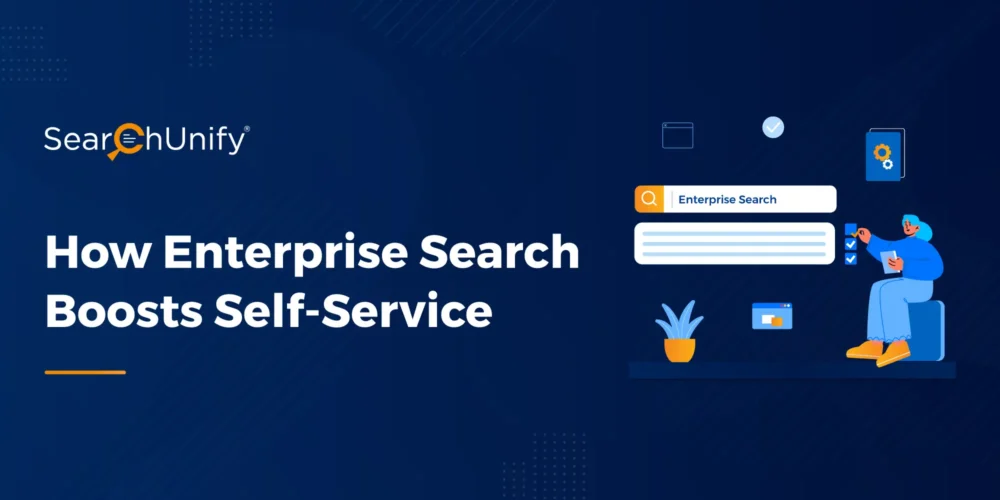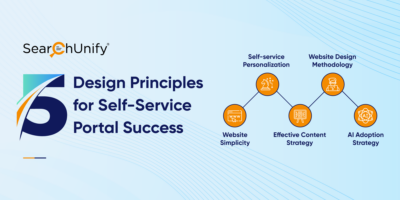
In an era where customers expect instant solutions and seamless experiences, self-service has become a vital tool for businesses. In fact, a recent study revealed that a staggering 77% of customers hold a more positive perception of brands that offer self-service options. This statistic is a clear indicator that underlines the significance of implementing self-service solutions across various industries.
However, implementing effective self-service is no cakewalk. It requires businesses to optimize their processes and ensure that customers can access relevant information quickly and easily.
That’s where organizations turn to robust and automated ways such as enterprise search solutions. These engines act as powerful allies in optimizing self-service experiences and revolutionizing how organizations interact with information.
Want to know more about self-service and why you should have a well-structured mechanism for it? Then give this post a read.
The Power of Self-Service
In a world driven by convenience, speed, and efficiency, self-service solutions empower customers by granting instant access to information and the ability to find solutions independently. These solutions range from online FAQs and knowledge bases to interactive chatbots and virtual assistants. By providing customers with the autonomy and control they desire, self-service options streamline customer interactions and reduce reliance on traditional support channels. The result? Higher customer satisfaction and loyalty.
But that’s not it. Self-service yields a lot more unimaginable benefits which include:
1. Accelerated Knowledge Discovery
Knowledge management plays a pivotal role in curating and organizing information. However, disseminating knowledge across an entire organization is not an easy task. Self-service capabilities help knowledge managers to create a centralized repository of information, making information easily accessible. As a result, employees can explore relevant documents, articles, and resources, saving valuable time and boosting their productivity.
2. Reduced Dependence on Support Teams
Support managers across the world face a common challenge: an overwhelming influx of queries. By implementing self-service, they can help their teams as well as the customers to find answers on their own. As a result, the dependence on support staff decreases, enabling the service representatives to focus on more complex and critical issues.
3. Improved Customer Satisfaction
Customer satisfaction is a key metric for businesses striving to provide exceptional service. By offering self-service options, organizations can empower customers to find answers independently without waiting for hours and hours to get their queries resolved. This facilitates higher satisfaction levels.
4. Enhanced Personalization and Contextualization
Self-service solutions provide personalized and relevant information to users based on their preferences, past behavior, and current context. This leads to a more efficient and satisfactory user experience, ultimately benefiting both customers and businesses.
5. Increased Scalability and Accessibility
Self-service options are available 24/7, providing customers with round-the-clock support regardless of time zones or geographical locations. Moreover, these solutions cater to a large number of customers simultaneously, ensuring scalability as the business grows.
Now that you know what self-service can do, how about courting the pressing issue: its optimal implementation.
Implementing Self-Service Applications: Best Practices and Considerations
No matter how crucial it is to self-service, very few organizations are able to nail it. This is why it is important to absorb best practices and considerations to improve your self-service capabilities. Here are a few to begin with:
1. Deploying an Enterprise Search Solution
An enterprise search solution empowers organizations by enabling employees to quickly find relevant information. This enhances productivity, streamlines workflows, and reduces dependency on manual assistance. However, choosing the right one and deploying it in the ecosystem is difficult. Here are a few key considerations to help you solve this issue:
- Scalability: Ensure that the chosen solution can scale with your organization’s growth. It should handle increasing volumes of data and users without compromising performance.
- User-Friendly Interface: Opt for an intuitive and user-friendly interface that requires minimal training for users to navigate and access information. A well-designed interface enhances adoption and improves the overall user experience.
- Advanced Search Capabilities: Look for a solution that offers natural language processing, Large Language Models, semantic search, etc. These features enhance the accuracy and relevance of search results, making it easier for users to find the information they need.
- Integration: Consider how well the enterprise search solution integrates with your existing systems and workflows. Seamless integration ensures a smooth transition and allows for the consolidation of data from various sources, providing a unified search experience.
2. Ensuring Data Security and Privacy
With the power of self-service comes the responsibility to safeguard sensitive data.
Adhere to the following considerations:
- Role-Based Access Control: Implement role-based access control to ensure that users can only access information relevant to their roles and responsibilities. This prevents unauthorized access to sensitive data and protects data integrity.
- Encryption and Data Governance: Implement end-to-end encryption to protect data both at rest and in transit from unauthorized access. Establish robust data governance practices to enforce data security policies, monitor data access, and track data usage.
- Compliance with Regulations: Ensure that the chosen enterprise search solution complies with relevant data protection and privacy regulations, such as GDPR or HIPAA, depending on your industry and location. Compliance helps maintain trust with customers and avoids potential legal and reputational risks.
- Regular Security Audits: Conduct regular security audits to identify vulnerabilities and address them promptly. Stay updated with the latest security patches and updates for the enterprise search solution to protect against emerging threats.
3. User Adoption and Training
To maximize the benefits of self-service applications, focus on user adoption and training, which include:
- User Training: Provide comprehensive training to users on how to effectively utilize the self-service channels. Offer workshops, tutorials, and documentation to familiarize users with the features and functionalities of the enterprise search solution.
- Continuous Education: Encourage continuous learning by organizing regular refresher sessions and sharing best practices. Keep users informed about updates and new features to ensure they make the most out of the self-service avenues.
- User Feedback and Improvement: Create a feedback loop where users can provide input on the self-service application’s usability and suggest improvements. Actively listen to user feedback and make iterative enhancements to enhance user satisfaction and adoption.
Final Thoughts
Embracing self-service channels is not just a necessity; it is an opportunity to transform your organization’s search capabilities and gain a competitive edge. So, take the leap, implement best practices, and embark on a journey to unlock the true potential of self-service applications.
Your knowledge ecosystem will thank you!


















